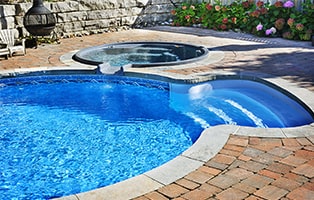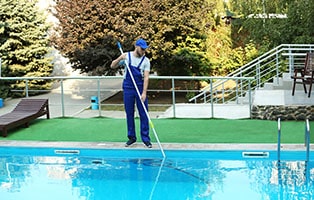Every pool owner needs to know how to clear a cloudy swimming pool fast. Our article has all the information you need to do that!
Owning a swimming pool can provide a much-needed respite from the oppressive summer heat. However, you won’t be able to experience the refreshing coolness of your backyard aquatic oasis if it’s cloudy. That’s because murky water not only looks disgusting but can be unhealthy to swim in. In this article, we’ll go over the most common causes of cloudy water and what you can do to clear it up. Let’s dive in!
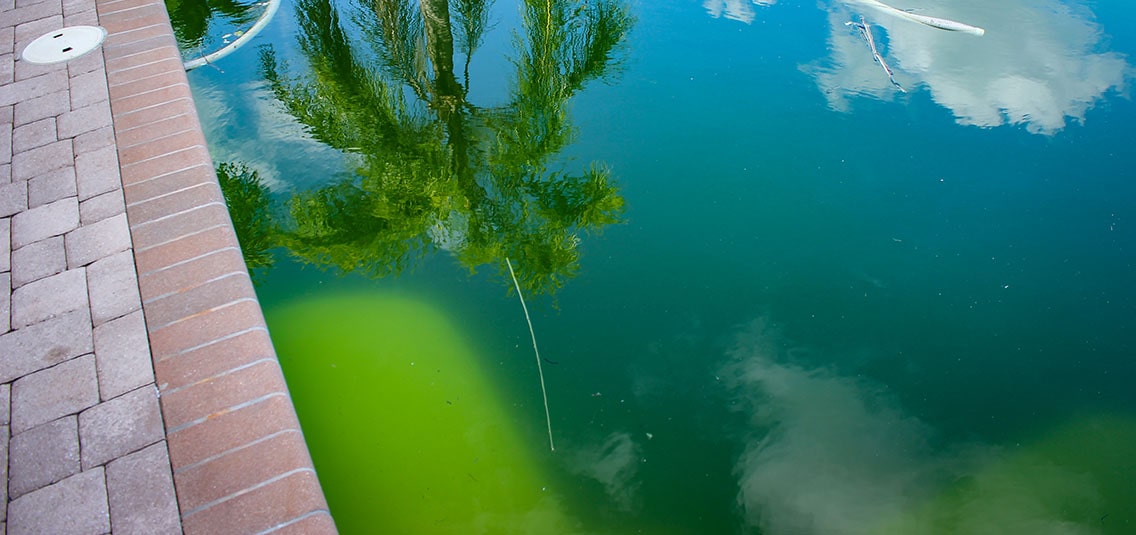
Poor Filtration
Filter problems are one of the biggest causes of cloudy pool water. That’s because if your filter isn’t functioning the way it was intended, it can’t remove the contaminants and other gunk that contribute to unswimmable murkiness. The solution is keeping your pool’s circulation system operating at its optimal level through regular maintenance and cleaning.
A clogged filter or a blockage in the skimmer line might be the cause of the cloudiness because it reduces your pump’s effectiveness. To find out if your pool filter is clogged, switch off the pump, and open the filter chamber to check for debris. If debris is blocking the filters, you’ll need to remove it and thoroughly clean your filter. DE filters need to be sprayed and flushed, while sand filters must be backwashed.
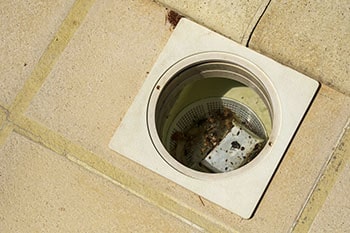
Cartridge filters need to be replaced every two to three years. If you have a sand filter, change it every five years or so. If you have a DE filter, regularly add fresh powder or replace the grids.
It could also be that you’re not running your filtration system long enough. All the water in your pool needs to run through the system at least once per day. For most pools, this means running your filter eight to 12 hours each day. For particularly cloudy water caused by inadequate filtration, you may need to run the filter 24 hours for a day or so.
Check the pump and filtration system for any broken parts that could adversely affect the water pressure or the ability of the system to filter out debris. Any parts that are severely worn or broken will need to be replaced.
Unbalanced Chemicals
Improperly balanced chemical levels can cause cloudy water. To see which chemicals might be at fault, use a pool test kit to check the composition of the pool water. Invest in a quality kit that tests for chlorine levels, bromine levels, pH levels, total alkalinity, calcium hardness, and cyanuric acid.
Free Available Chlorine (FAC)
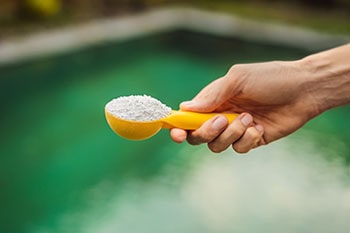
One chemical to test for is free available chlorine (FAC). This is the chlorine available to sanitize your pool water. Combined chlorine (CC) is chlorine that has already been used up, oxidized, or diluted with the ammonia and nitrogen compounds in the water. Total available chlorine (TAC) is the sum of free and combined chlorine.
Low free chlorine levels are caused by heavy pool usage, lots of rain, or an abundance of ultraviolet light (UV). Rain dilutes chlorine, and UV (ultraviolet light) from the sun oxidizes free chlorine. If your pool is in direct sunlight, consider adding a chlorine stabilizer such as cyanuric acid (CYA) and a pool cover when you’re not using your pool. This will help prevent the free chlorine from being oxidized.
However, keep in mind that cyanuric acid is particularly potent. It will have the opposite effect if you exceed the recommended levels, causing FAC levels to plummet. CYA levels should be between 30 and 50 ppm (parts per million).
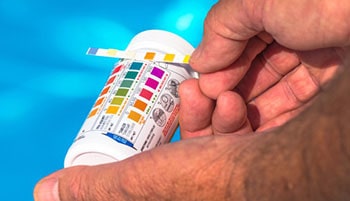
When your pool water doesn’t have enough FAC, the chlorine present in the water won’t be powerful enough to eradicate harmful germs and algae-causing bacteria. This could make your pool water murky, and the water will also have too much chloramine in it. This not only adds to the murkiness but gives the water a strong chlorine smell. Chloramine can also irritate sensitive areas of the human body and corrode pool fixtures and equipment.
The greater the range between free and total chlorine, the more combined chlorine is present in your swimming water. You can test free chlorine by using test strips, a liquid test kit, or taking a sample to your local pool supply store. Free chlorine should be between 2.0 and 4.0 ppm, and the combined chlorine in your water should be below 0.5 ppm. Test chlorine levels daily and adjust as needed.
The best way to boost chlorine levels is by shocking your pool (see below). Shocking your pool once weekly during pool season refreshes sanitizer levels and prevents cloudy water.
pH Levels

The pH level in pool water affects how all other chemicals behave, including chlorine. When pH levels get too high, chlorine becomes ineffective.
High pH levels also cause calcium not to properly dissolve. This can lead to not only cloudy pool water but also scaling. Scaling is white crusty deposits that look like crystalline salt.
pH should be between 7.4 and 7.8. You’ll need a pH reducer such as muriatic acid to lower pH. Also, ensure that total alkalinity (TA) is between 80 ppm and 120 ppm. This will prevent pH levels from rising too much. To lower TA, add muriatic acid.
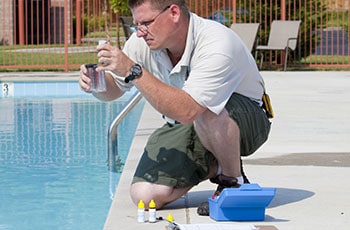
Calcium Hardness
Calcium hardness should be between 180 to 220 ppm. You can lower it by adding a pool flocculant (see below) to clump the calcium. Raise it by adding calcium chloride.
High levels of CH (calcium hardness) in your pool water mean that calcium can’t dissolve. This leads to calcium scaling. Sometimes, scaling might even clog your filter. The only way to lower CH levels is to partially drain and refill your pool water.
Total Alkalinity (TA)
You’ll need to closely monitor changes in the TA (total alkalinity) levels. High TA levels cause PH and calcium scaling, which contribute to cloudiness. To lower TA, you’ll aerate the water after adding muriatic acid. This process raises pH to recommended levels.
Weather
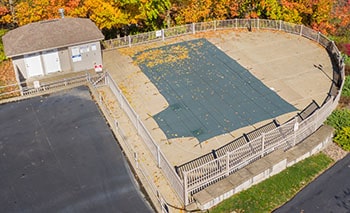
Weather is yet another cause of cloudy water. Rain and strong breezes can cause pollen, dirt, pollution, and other particulate matter to end up in your pool. Some of this stuff contains phosphates, a chemical that algae love to feast on. That’s why you should probably check the pH, chlorine, and other chemical levels if your pool appears murky after a rainstorm.
If you know you’re going to get rain, ensure that there’s enough chlorine to counteract any dilution it can potentially cause. The filter should also be running while it’s raining.
Use a net to get rid of visible foreign matter left by rain or wind. To eradicate algae, clean your pool using a large leaf net and then vacuum it. Afterward, shock your pool if any algae remains.
If cloudiness persists after doing all this, use a pool clarifier (see below). This will coagulate all the foreign particles so they can be picked up by the filter. If the pool clarifier doesn’t work, use a flocculant. For a fantastic way to keep foreign matter out of your pool, check out the best smart robots.
Body Waste
Body oil and sunscreen from swimmers washes off in the water and accumulates, contributing to cloudiness. All this can overwhelm your sanitizer and filter.
Ways to Clear Up a Cloudy Pool
Shock It
Shocking is adding pool chemicals to raise the free chlorine level. The objective is to increase this level to destroy algae, chloramines, and bacteria. These factors are among the most common causes of cloudiness.

A pool that smells strongly of chlorine isn’t a sign that it’s clean. On the contrary, it means the opposite. A clean pool will be practically odor-free. Chlorine odor comes from chloramines, also known as combined chlorine (CC). Chloramines form when pool chlorine combines with the nitrogen in oils, sweat, and urine.
You should probably shock your pool when:
- Algae begins to grow in your pool
- The free chlorine level of your pool measures zero
- The chloramines or combined chlorine level rises above 0.5 parts per million (ppm)
When you’re shocking a pool, the goal is to raise the free chlorine level of the pool water to roughly 10 times the combined chlorine level. Reaching this mark is called the “breakpoint chlorination” point. Shocking should be done at night because the sun’s rays will burn off unstabilized chlorine.
Here’s how to shock a pool:
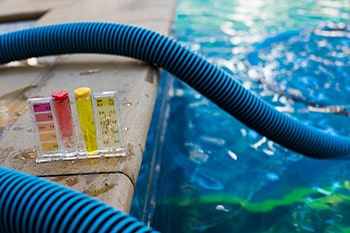
- You’ll need to first run a test to determine the combined chlorine level. To do that, subtract the free chlorine from the total chlorine. This will let you know how much chlorine you need to add to the pool.
- Calculate the amount of shock you’ll need by looking at the package.
- Wear gloves and safety glasses while working with pool chemicals. You can add some granular pool shock to your swimming pool directly. However, most brands need to be mixed with water before use. You can mix granular pool shock with water ahead of time. This will save you time and help prevent calculation mistakes. Liquid pool shock is also available.
- Ensure the pool pump is running.
- Pour the mixture into the water around the edges of the pool.
- Let the pump run for 6 hours or more.
- Test the water to ensure proper chlorine levels.
- Don’t use the pool right away. Wait for the free chlorine levels to drop to 1 to 3 ppm.
Use a Pool Clarifier

Using a pool clarifier is one solution you can try when your swimming pool water is cloudy, and other methods don’t seem to work. A clarifier is a chemical that acts as a coagulant, bonding together loose dirt, pollen, and other small debris.
This increases the size of the loose particles, making it easier for the filtration system to pick them up. Clarifiers work with any filter type but are best with cloudy water issues that aren’t too bad.
Before using a clarifier, it’s crucial to ensure there isn’t another reason for the pool’s cloudiness. Although the clarifier can clear up the water quickly, you should correct any underlying problem to prevent the problem from raising its ugly head in the future.
Here are the steps:
- Run your swimming pool filter system for 24 to 48 hours. If the pool is still cloudy, continue with the next step.
- Add the correct amount of clarifier to your swimming pool according to the package directions. Quantities will depend on your pool’s capacity.
- Allow your pool to sit with the filter system running overnight. This allows the clarifier to clump the particulates together so that the filter system can remove them.
- Vacuum out any clumped particles that the filter didn’t remove. Keep the filter running as you vacuum to remove any pieces that break off while vacuuming.
- Test your swimming pool water for chemical levels. When the pool levels are back to normal, the pool is safe for swimming.
Use a Pool Flocculant
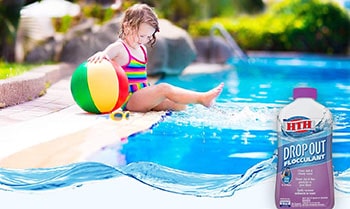
Like a clarifier, flocculant, or “floc,” is a chemical you add to a cloudy pool when other methods don’t work. Flocculant also causes particles of contaminants to stick together. However, unlike a clarifier that causes the clumping particles to float to the top, floc creates large clumps that sink to the bottom.
Because a clarifier is a milder chemical, it will take several days to completely clear up a cloudy pool. However, a flocculant works almost immediately. Also, flocculants shouldn’t be used with cartridge filters, while clarifiers are safe for all filtration systems.
If you’re planning on having a fabulous pool soiree in a few hours, or if your pool is extremely cloudy, then flocculants are the way to go. However, if time isn’t of the essence, a clarifier is usually better.
Here’s how you floc a pool:
- Because you’ll probably lose some water during the process, it’s best to fill your pool to its highest level before you begin. That way, you don’t risk the water dropping too low, rendering your filtration system ineffective.
- Because flocculants can affect the pH level, you’ll want to start at about a 7.0 pH. That way, you can ensure your sanitizer keeps working at maximum efficiency.
- Read the directions on the bottle to find out how much water to add to dilute it. Then, dilute the water.
- Pour the diluted flocculant around the edges of the pool.
- Run the pool pump for a few hours. This allows the flocculant to be dispersed to every square inch of the pool.
- Turn the pump off and let it sit overnight. The water needs to be as still as possible for about eight hours so that it has time to collect all the particulate waste.
- Set the filter valve to “waste,” and switch the pump on. This will help filter out all the sediment on the bottom of the pool.
- Vacuum the bottom of the pool to get all the junk the filter couldn’t get.
- Immediately replace any water lost when you did the vacuuming.
- Backwash your filters to clean out all the sediment and leftover chemicals left in them.
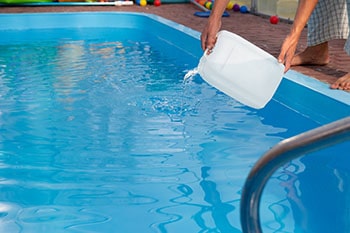

You can use an algaecide to kill the early stages of green algae that can cloud up your pool water. However, the best method of getting rid of algae is using a large leaf net and vacuum. Afterward, kill any residual algae with a chlorine shock.
Only use algaecide when algae first starts to show up. That’s because algaecide isn’t helpful once an algae outbreak is widespread. Some algaecides even contain copper, which can make your pool water cloudy instead of clearing it up.
Final Thoughts
Clearing up a cloudy pool isn’t rocket science. By following a precise methodology, you’ll be able to eradicate the murkiness that keeps you from taking a refreshing dip when the weather outside is sweltering.
Do you have any other tips to add? Let us know in the comments!

Pool Maintenance Tips & Tricks
